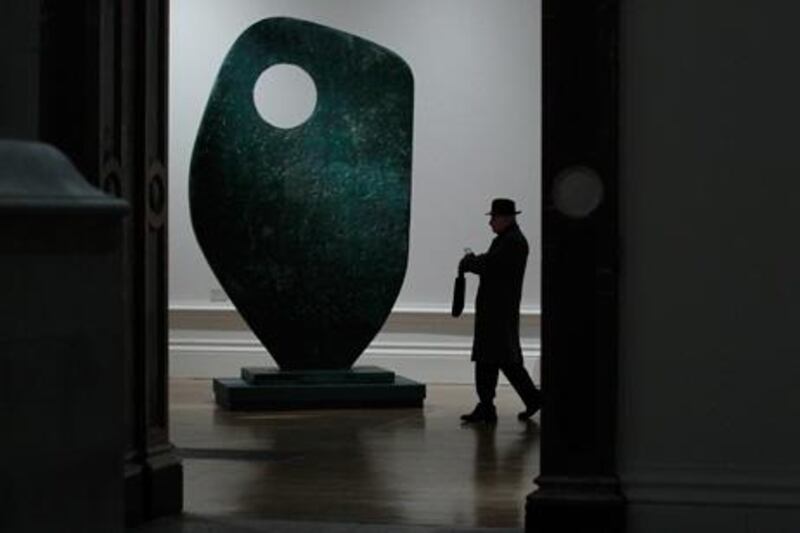What's British about British sculpture, and what's borrowed from Iraqi design, American minimalism and Chinese ceramics? It's a question posed by the curators of a major new exhibition at the Royal Academy, along with the question "What's sculpture itself?" Tantalisingly, answers to neither are given in the materials surrounding Modern British Sculpture (which will run until April 7), but the arrangement of art from the last 100 years, sometimes placed alongside foreign works that might have inspired them, suggests lots more ideas, questions and possible solutions.
It's a story in which the Middle East plays its part. In a room in which naive-looking carvings from the early 20th century - totem poles, lumpy human figures rendered in limestone, parts of faces or bodies - are set next to ancient artefacts borrowed from the British Museum, there are chiselled reliefs from 7th- and 9th- century northern Iraq.
The angles, arrangement of bodies and technique helped Charles Sargeant Jagger come up with his War Memorial reliefs of wounded soldiers, which are also on display close by in the form of plaster-cast replicas. The room also houses pieces by Barbara Hepworth and Jacob Epstein (an American émigré who became a British citizen in 1911) next to carvings from 18th-century Congo, Aztec Mexico, and ancient Greece, India and Egypt.
London was the place to be for artists in the early 20th century, according to one of the show's organisers, Adrian Locke, precisely because as the centre of the British empire, it was full of anthropological and artistic treasures collected from around the globe. "The world is now so much more international," he said at the exhibition's press launch, "that it's hard to think that someone like Epstein deliberately came to England in 1905 to spend more time at the British Museum."
While classical sculptures were moulded from clay or plaster, and then replicated in marble or bronze, carefully etched and whittled carvings made from stone and wood inspired the likes of Epstein to "stay true" to their materials. In the next room is a copy of Epstein's autobiography, Let There Be Sculpture. "Imitation is no aim of sculpture proper," one line reads, "and a true piece of sculpture will always be the material worked into the shape." In other words, it's still a huge piece of rock.
The impact of Chinese pottery on the abstract shapes of Barbara Hepworth and others of her generation is similarly suggested, as delicate ceramics are juxtaposed with smooth, curving sculptures in neutral colours. An entire room is dedicated to the work of Hepworth and her contemporary Henry Moore further on in the show: Hepworth's Single Form (best known in its incarnation at the UN plaza) stands in plenty of space, opposite Moore's undulating Reclining Figure. Although the first is abstract and the second figurative, both make much of the texture and mass of their materials: they owe a debt to Epstein.
"They put British sculpture on the map," Locke says of Moore and Hepworth. "There was a time when they were quintessentially British." Now, he says, it's difficult to define Britishness at all. "Maybe it's a term that's now obsolete," he reflects. "The world is so international now, you can get on a plane; you can look on the internet; thousands of books are available with reproductions and commentaries; there are grants and biennials." Or perhaps, if it's true that Epstein influenced Moore and Hepworth and he in turn was inspired by the collections in the British Museum, "Britishness" never really existed in art.
That display, dating to the 1950s and 1960s, is the last room containing objects that are recognisable as sculptures. After that, we get Victor Pasmore and Richard Hamilton's Exhibit, which was originally displayed in 1957 and can be seen as an early example of installation art, with coloured sheets suspended at angles to one another, through which the visitor can walk. It's visible from the room showing Anthony Caro's Early One Morning - steel girders and poles welded together and painted pillar-box red - which dispenses with a plinth and prepares us for another grouping devoted to Land Art, containing photos and installations by Richard Long, among others. Here, the art mostly happens outside the exhibition, in the British countryside, and what's brought back are photos and documentation.
And then there's Damien Hirst. The impact of his vitrine Let's Eat Outdoors Today has a sledgehammer force: the room-sized glass box is thick with flies that buzz, crawl, breed and die on the remnants of a barbecue and a severed cow's head. "The Hirst is the end of a tradition, not the beginning of a new one," Penelope Curtis said of the piece, admitting that she and her co-curator Keith Wilson "couldn't make the next step after Hirst," and ended the show on a different tack. "For the exhibition we had to learn how to deal with the last 10 years," she said, "and a lot of that was actually looking at how artists could make sculpture after Hirst. What do you do after Hirst?"
Although Hirst is one of many household names in the show, Modern British Sculpture doesn't contain anything that's superfluous to its story - and neither does it suggest its story is the only one that's possible to tell. There's no Antony Gormley or Anish Kapoor - two of Britain's best-loved contemporary sculptors - and there's no mention of Gilbert and George's notion of themselves as "living sculptures". Apart from wall texts introducing the theme of each room, there is also little in the way of explanation of the works, which are given plenty of breathing space and trusted to speak for themselves. The result is awe-inspiring, open-ended and full of surprises.





